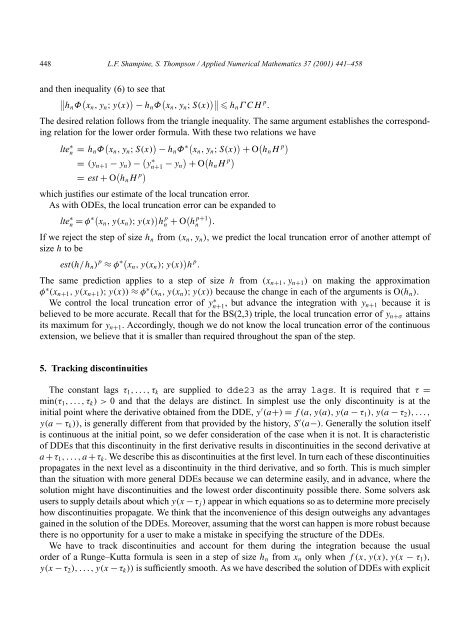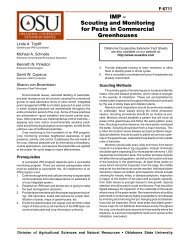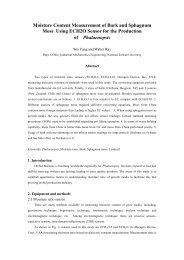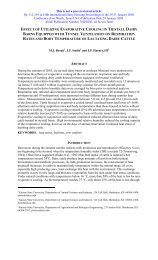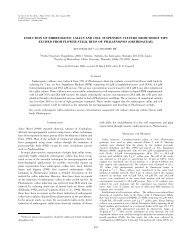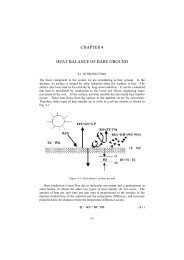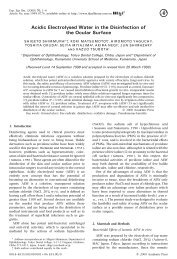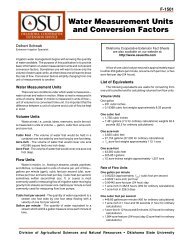Solving DDEs in MATLAB
Solving DDEs in MATLAB
Solving DDEs in MATLAB
You also want an ePaper? Increase the reach of your titles
YUMPU automatically turns print PDFs into web optimized ePapers that Google loves.
448 L.F. Shamp<strong>in</strong>e, S. Thompson / Applied Numerical Mathematics 37 (2001) 441–458<br />
and then <strong>in</strong>equality (6) to see that<br />
<br />
hnΦ xn,yn; y(x) − hnΦ xn,yn; S(x) hnΓCH p .<br />
The desired relation follows from the triangle <strong>in</strong>equality. The same argument establishes the correspond<strong>in</strong>g<br />
relation for the lower order formula. With these two relations we have<br />
lte ∗ n = hnΦ xn,yn; S(x) − hnΦ ∗ xn,yn; S(x) + O hnH p<br />
<br />
+ O hnH p<br />
= (yn+1 − yn) − y ∗ n+1 − yn<br />
= est + O hnH p<br />
which justifies our estimate of the local truncation error.<br />
As with ODEs, the local truncation error can be expanded to<br />
lte ∗ n = φ∗xn,y(xn); y(x) h p n + Oh p+1<br />
n .<br />
If we reject the step of size hn from (xn,yn), we predict the local truncation error of another attempt of<br />
size h to be<br />
est(h/hn) p ≈ φ ∗ xn,y(xn); y(x) h p .<br />
The same prediction applies to a step of size h from (xn+1,yn+1) on mak<strong>in</strong>g the approximation<br />
φ ∗ (xn+1,y(xn+1); y(x)) ≈ φ ∗ (xn,y(xn); y(x)) because the change <strong>in</strong> each of the arguments is O(hn).<br />
We control the local truncation error of y ∗ n+1 , but advance the <strong>in</strong>tegration with yn+1 because it is<br />
believed to be more accurate. Recall that for the BS(2,3) triple, the local truncation error of yn+σ atta<strong>in</strong>s<br />
its maximum for yn+1. Accord<strong>in</strong>gly, though we do not know the local truncation error of the cont<strong>in</strong>uous<br />
extension, we believe that it is smaller than required throughout the span of the step.<br />
5. Track<strong>in</strong>g discont<strong>in</strong>uities<br />
The constant lags τ1,...,τk are supplied to dde23 as the array lags. It is required that τ =<br />
m<strong>in</strong>(τ1,...,τk) >0 and that the delays are dist<strong>in</strong>ct. In simplest use the only discont<strong>in</strong>uity is at the<br />
<strong>in</strong>itial po<strong>in</strong>t where the derivative obta<strong>in</strong>ed from the DDE, y ′ (a+) = f (a,y(a),y(a − τ1), y(a − τ2),...,<br />
y(a − τk)), is generally different from that provided by the history, S ′ (a−). Generally the solution itself<br />
is cont<strong>in</strong>uous at the <strong>in</strong>itial po<strong>in</strong>t, so we defer consideration of the case when it is not. It is characteristic<br />
of <strong>DDEs</strong> that this discont<strong>in</strong>uity <strong>in</strong> the first derivative results <strong>in</strong> discont<strong>in</strong>uities <strong>in</strong> the second derivative at<br />
a +τ1,...,a+τk. We describe this as discont<strong>in</strong>uities at the first level. In turn each of these discont<strong>in</strong>uities<br />
propagates <strong>in</strong> the next level as a discont<strong>in</strong>uity <strong>in</strong> the third derivative, and so forth. This is much simpler<br />
than the situation with more general <strong>DDEs</strong> because we can determ<strong>in</strong>e easily, and <strong>in</strong> advance, where the<br />
solution might have discont<strong>in</strong>uities and the lowest order discont<strong>in</strong>uity possible there. Some solvers ask<br />
users to supply details about which y(x −τj) appear <strong>in</strong> which equations so as to determ<strong>in</strong>e more precisely<br />
how discont<strong>in</strong>uities propagate. We th<strong>in</strong>k that the <strong>in</strong>convenience of this design outweighs any advantages<br />
ga<strong>in</strong>ed <strong>in</strong> the solution of the <strong>DDEs</strong>. Moreover, assum<strong>in</strong>g that the worst can happen is more robust because<br />
there is no opportunity for a user to make a mistake <strong>in</strong> specify<strong>in</strong>g the structure of the <strong>DDEs</strong>.<br />
We have to track discont<strong>in</strong>uities and account for them dur<strong>in</strong>g the <strong>in</strong>tegration because the usual<br />
order of a Runge–Kutta formula is seen <strong>in</strong> a step of size hn from xn only when f(x,y(x),y(x − τ1),<br />
y(x − τ2), . . ., y(x − τk)) is sufficiently smooth. As we have described the solution of <strong>DDEs</strong> with explicit


